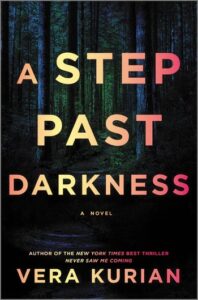When I set out to write my second novel, A Step Part Darkness, I knew it was a lot more ambitious than my debut had been. Several elements made it more complicated: it has a dual-timeline with a separate but related mystery in each and it had an ensemble cast. Specifically, it had six main characters, each of whom would have their own POV in both timelines. When ensemble casts are good, they are so satisfying to readers, but when they are bad, they feel quite hollow, often because they’re rendered somewhat lifelessly—we’re simply told that this is the gang and that they’re bonded rather than this sentiment being earned through elbow grease.
A Step Past Darkness is very deliberately an homage to Stephen King’s It—I’m a King fan and like many King fans, it’s my favorite of his books. I studied it—its structure, what worked about it, and what didn’t. One of the things I deeply admire about the book is that despite there being seven main characters, each of them felt fully realized. I used to reread that book every year when I was in high school, but a couple years ago I returned to it for more of a craft study.
The way he does this is by introducing you to each character in chapters devoted to them in the first timeline in the 1950s. Yes, you are seeing how the Losers Club gets together, and the start of scary things happening, but each of those introductory chapters has deep interiority to them. You see each kid’s internal state, what they care about and what they fear, how they occupy their time and what their families are like. King naysayers, say your nays, but people who know his writing know that he cares about his characters. Particularly in It, you can feel the compassion he has for them, the tenderness with which he treats them, though this does not mean that they won’t face peril or even death.
How could I do that? And how could I do that—meaning a newer author who doesn’t have the gravitas and extended publishing record to get away with a 1,000 plus page novel the way King did? I had a vague sense of what the plot of my novel would be, and I’m a strict believer in plotting out books almost to their entirety (particularly when one is under deadline), but before I even started doing that, I spent a solid month working on character. I did not write a single line of prose.
Effectively forming a cast of fully realized characters and then understanding them as a group required two thorough steps.Effectively forming a cast of fully realized characters and then understanding them as a group required two thorough steps. The first was answering the question, “Who are they?” I like to think of character creation as me as the artist looking at an iceberg covered with fog. The more examine it, the more the fog rolls back. When it’s more or less completely uncovered, some of the ice is beneath the surface and some is above; I’ve done more preparatory work than what will be shown to the reader, but that works still matters. I’m a visual person—I basically see scenes of my books in my head before I write them down. I can’t “see” a person if they don’t have a face. I start by poking around the internet to find a picture of someone that feels right to me. Then for each character I go through two extensive questionnaires. One is a basic one—you could find one of these easily on the internet—that has questions like, “what are their hobbies?” and “how do they dress?” Some of these questions focus on inner psychology where some are more surface level, but in either case, I answer them in detail.
Too often we are told “Jane had blonde hair and blue eyes and was beautiful.” But that doesn’t really tell us anything about what she actually seems like when she’s in a room with us. The Jane I described above could be beautiful, but painfully awkward, always walking with turned-in shoulders and her head bowed. Or she could be other worldly, a Galadriel in human form. Or she could be a down-home farmgirl with massive hands and a bawdy sense of humor you can see in her eyes. Too often we’re told “he’s the hot star quarterback.” I kind of have this character in my book: the uber-popular football player. Except I didn’t make him a quarterback because too often it seems like writers just pick quarterback because they don’t know anything about football and associate “quarterback” with “good” (the same way they use Harvard to signal smart). I researched a lot of things about football. I read books and watched documentaries. I saw how hard these kids work, often from young ages. I started to think of this character—Casey—and what it would take to be that good at football to get to the potential of being recruited by colleges. How devoted he is, how obsessed with football, but also how self-conscious, how badly he wants the approval of others.
The second questionnaire I fill out is the Proust Questionnaire, which you can find online. These questions get more at philosophical questions, things like, “What is your idea of happiness?” People might even find these questions hard to answer for themselves. Sometimes I just don’t know the answer for the character, so I make it up on the spot. This is why character creation feels like an uncovering to me: I’m moving the fog away from the iceberg, making up things that feel “right” to me. This forms a sort of three-dimensional sense of them in my head that, even after I finish the questionnaire, gets increasingly more detailed as I start writing. This doesn’t mean that anything is written in stone: recently I went back to these questionnaires for A Step Past Darkness—which I initially filled out in 2021, and saw that I wrote that one character had on the floor of his bedroom both a Robert Jordan book and The Anarchist Cookbook. I laughed because that was so wrong—he would have the second book but not the first. I didn’t know that then, but I know it now.
The next important thing for an ensemble cast was to consider group dynamics. We can’t just be told “they are all besties, except one is the smart one, one is the athletic one, etc.” Well, because one, we’ve just established these people as three dimensional, and two, within any group of people there are multiple different sets of tensions and minigroups. We can’t, and shouldn’t, always be given the ensemble in its entirety. One scene I loved in It was when Bev spends an afternoon hanging out with Ben, Eddie, and Stan. We don’t need all the characters there, and the dynamic changes depending on the mini-group. Say what you will about LOST, but the first season is an incredible depiction of an ensemble cast, and over the course of the show, it’s pleasing to see pairings, mini-groups, and dynamic things happening across the cast. There’s a love triangle with Jack, Kate, and Sawyer. Sawyer and Sayid have an antagonistic relationship. Kate has a natural affinity with other women on the island like Claire and Sun. If looking for successful depictions of ensemble casts and their dynamics in novels, there are a few good starting points: highly rated war novels (because they often focus on a unit of people), multigenerational sagas (with the family functioning as a unit), or epic fantasies (which often have a band of people working together).
The last thing I did was consider how these two things—character and group dynamics—shift as a function of time. When I was coming up with characters, I literally drew an arc. How would this person change over time? What was their primary psychological struggle as a child, and how would that manifest in adulthood? How were they affected by the trauma of the first time point of the novel? What do they think of who they were and who they have become? I wanted the reader to feel like they went on a journey of following this group of people from teenagers to adulthood, and to feel as if they had traveled on a satisfying arc. In the best case scenario, the reader closes the book with a sad little sigh and misses the friend group they are leaving behind.
***
Vera Kurian is a writer and scientist based in Washington DC. Her debut novel, NEVER SAW ME COMING (Park Row Books, 2021 was an Edgar Award nominee and was named one of the New York Times’ Best Thrillers of 2021. Her short fiction has been published in magazines such as Glimmer Train, Day One, and The Pinch. She has a PhD in Social Psychology, where she studied intergroup relations, ideology, and quantitative methods. She blogs irregularly about writing, horror movies and pop culture/terrible TV. Her new novel, A Step Past Darkness, is now available. She has extended craft articles on her Substack.














